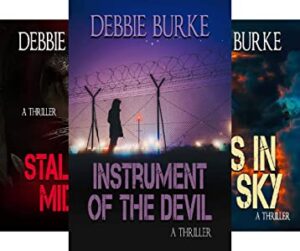
Photo credit: Ray Bilcliff, pexels
by Debbie Burke
@burke_writer
Happy New Year! Hope the spirit of the holiday season kept you warm in spite of the frigid weather.
What better way to kick off the first week of the new year than with a First Page critique? Please take a plunge into Deadly Water submitted by a Brave Author.
~~~
Deadly Water
Kit sat on the back steps and laced up his running shoes. Getting a bit battered he thought. Might have to invest in a new pair if I plan on doing that marathon later in the year. Jumping nimbly to his feet, and making sure he had the ball in his pocket, he set off up the road towards the beach. Gem trotting happily beside him.
The day had one of those dirty gray overcast skies that were full of rain. The forecast was indeed for it to bucket down later. Kit knew these skies well, having grown up on the street he still lived. Rain would come from the north east, and it would last for a few days. Given his current mood this suited him perfectly well.
Down on the beach the tide was well out. Despite the number of runners, walkers, dogs, and strollers, there was plenty of room for Kit and Gem. As she had done for countless kilometers, Gem was content to lope alongside Kit. Half border collie, half German Shepard, Gem was a true companion. Loyal, obedient, and possibly deadly. Strangers never knew if Gem was going to herd them, or rip their lungs out.
Kit ran with one of those easy strides that made running look easy. He was tall, with hair that wasn’t quite red, not quite auburn. With that, and his green eyes, he could either scrub up stunningly, or just as easily look like he had slept rough for days.
They did the mandatory four lengths of the beach. Kit then took the disgusting old tennis ball out of his pocket and threw it into the water for Gem to chase. He still had a good throwing arm from his cricketing days, so this gave Gem a good workout. The sprint up the hill home always made him feel virtuous.
Back home he made his regular breakfast of egg with tomatoes on toast, and fed Gem. It was now getting on for seven thirty, and Kit wasn’t sure what he was going to do with the rest of the day. The house really did need some work, especially the fence. Ever since his parents had died, and Kit inherited the house, he had not much felt like renovating.
The promised rain arrived.
It was on day three of the rain that his mobile went. It hadn’t rung for days. His mates knew better than to annoy him when the mood was on. Kit and Gem had still run every morning. Running as therapy Kit thought grimly to himself more than once.
~~~
Okay, let’s get started.
Title: A title makes the book’s first impression on a reader and Deadly Water fills the bill for the mystery/suspense/crime genre. It immediately raises the question—why is the water deadly? That promises sinister happenings–maybe a floating body, murder by drowning, or a dangerous hunt for undersea treasure.
The title also works to set the story’s mood. Treacherous seas evoke primal fears of being lost, alone, and helpless in the depths, along with the terror of being unable to breathe. BA made an evocative, effective choice with Deadly Water. Good job!
Craft: The writing is generally clear. No typos or spelling errors except “Shephard” should be “Shepherd.”
“Might have to invest in a new pair if I plan on doing that marathon later in the year.” This is the only place where “I” is used. The rest of the page is in third person.
For consistency, consider changing I to he: “Might have to invest in a new pair if he planned on doing that marathon later in the year.”
“Well” is repeated twice in two paragraphs.
The phrase “one of those” appears twice and is unnecessarily vague and wordy.
Try reading this page out loud to pick up repeated words and to smooth out a few awkward phrases.
Beginning a sentence with “It was” sounds weak. What does it refer to?
Watch out for gerunds (-ing words). “Jumping nimbly to his feet, and making sure he had the ball in his pocket, he set off up the road towards the beach. Gem trotting happily beside him.”
Suggested rewrite: Kit made sure he had Gem’s ball in his pocket. He jumped to his feet and set off up the road towards the beach, the dog trotting happily beside.
Setting and tone: British-isms like “scrub up” and “mates”, as well as the reference to “cricket”, suggest the setting is an English seaside town.
“Dirty gray overcast skies that were full of rain” is a nicely written phrase that establishes a gloomy, threatening tone.
“Given his current mood this suited him perfectly well” indicates Kit feels melancholy.
Characters: Two characters are introduced, Kit and Gem.
Kit is a fit marathon runner who still lives on the same street where he grew up. He recently inherited a home after his parents’ deaths.
Kit ran with one of those easy strides that made running look easy. He was tall, with hair that wasn’t quite red, not quite auburn. With that, and his green eyes, he could either scrub up stunningly, or just as easily look like he had slept rough for days.
This description gives a clear picture of what Kit looks like. However, the point of view is omniscient—as if a god is looking down on him—in contrast with the third-person POV in the rest of the excerpt.
An important goal at this early stage is to interest and connect the reader closely with the main character. Switching the POV pulls the reader out of the story, which is risky.
Gem is described as:
Half border collie, half German Shepard, Gem was a true companion. Loyal, obedient, and possibly deadly. Strangers never knew if Gem was going to herd them, or rip their lungs out.
Whoa! Ripping lungs out grabs the reader’s interest in a big way. I want to know more about this dog.
What causes her to react with unexpected violence? Is she trained to attack? If so, why does Kit need or want an attack dog? Should she be off-leash on a public beach? How does Kit handle Gem’s scary behavior?
At this point, Gem is a far more interesting, compelling character than Kit. She is also an effective device to foreshadow future conflict.
Story Problem: This otherwise well-written page has a major flaw.
Nothing happens.
Here are the problems Kit faces on this page:
Should he buy new running shoes?
Can he motivate himself to fix the fence?
His mobile goes dead.
None of these problems is compelling or earth-shaking.
The reader doesn’t care. And that’s a BIG problem.
A side note: I was confused by the sentences “It was on day three of the rain that his mobile went. It hadn’t rung for days.”
On the first reading, I thought “his mobile went” meant the phone had gone dead. On rereading, I wondered if the first sentence was missing a word. Should it have read “his mobile went off”? In other words, did it ring for the first time in days?
If in fact the phone does ring for the first time in days, that constitutes a disturbance, which I’ll discuss in a moment. However, since the reader doesn’t know the significance of an incoming call, it’s not a compelling hook.
Back to the story problem. BA hints at potential difficulties. Kit is depressed enough that his mates know not to call him. He considers running as therapy but doesn’t address why he needs therapy. If his mood is connected to the deaths of his parents, how does that lead to a larger story question?
At TKZ, we talk frequently about ever-shorter attention spans. Reading is only one activity in world filled with constant distractions.
For authors seeking traditional publication, agents and editors need to be grabbed by the first page, paragraph, or even sentence. Otherwise, they quickly move on to the next submission.
The same applies to self-published authors. The “Look Inside” sample must immediately grab a prospective buyer’s attention. If not, there are a few million other books they can check out.
This first page is not a story yet because there is no disturbance or conflict. It’s just another day in the lives of Kit and Gem where nothing out of the ordinary happens.
The background may be useful to help the author become familiar with the setting and characters.
But…it’s boring for the reader.
My guess is the real story begins a few pages later when a significant event changes the course of Kit’s life.
Unfortunately, most readers won’t stick around that long. To hook them, put the disturbance on the first page, preferably in the first few paragraphs.
What if Kit throws the ball for Gem to retrieve but instead she brings back a severed hand?
Bam! The story is off and running.
Here’s one possible way to begin:
Kit’s mobile went dead during his regular morning run along the seashore, deserting him when he needed it most.
Gem, his German Shepherd-border collie mix, was racing down the beach after her ball. Abruptly, she stopped to sniff a pile of flotsam that three days of windswept rain had washed ashore. As Kit approached, he noticed a stench besides rotting seaweed.
A body.
He started to call emergency services then realized his phone was dead, as dead as the young woman handcuffed to a wooden rail.
Jim Bell frequently counsels writers to “act first, explain later.”
To make this first page effective, try beginning with action. What disturbance changes Kit’s predictable, monotonous life into a story adventure?
The background information—like his familiarity with weather patterns, his parents’ deaths, and that he lives on the same street where he grew up—can all be woven in later, after the reader is hooked.
Summation: This page has potential. I like the English seaside setting and Gem is an interesting character. The excellent title promises that something bad is going to happen.
If BA rewrites the first page with action that lives up to the title’s promise, the reader will be eager to plunge into those Deadly Waters.
Thanks for submitting, Brave Author!
~~~
Over to you, TKZers. What do you think of this first page? What suggestions do you have for the Brave Author?
~~~

Start the New Year with a new series. Please check out award-winning Thrillers with Passion by Debbie Burke.
Amazon link






















